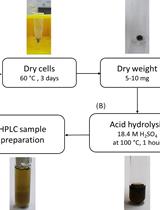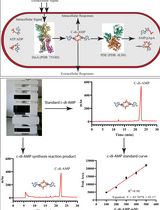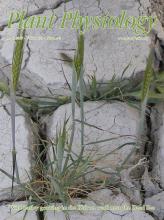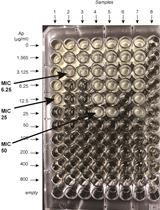- EN - English
- CN - 中文
Determination of Mn Concentrations in Synechocystis sp. PCC6803 Using ICP-MS
采用ICP-MS测定集胞藻PCC6803中Mn的浓度
(*contributed equally to this work) 发布: 2017年12月05日第7卷第23期 DOI: 10.21769/BioProtoc.2623 浏览次数: 8297
评审: Maria SinetovaElizabeth LibbyAnonymous reviewer(s)

相关实验方案

酸水解-高效液相色谱法测定集胞藻PCC 6803中聚3-羟基丁酸酯的含量
Janine Kaewbai-ngam [...] Tanakarn Monshupanee
2023年08月20日 1503 阅读

基于高效液相色谱法的史氏分枝杆菌DisA环二腺苷酸(C-di-AMP)合成酶活性研究
Avisek Mahapa [...] Dipankar Chatterji
2024年12月20日 1423 阅读
Abstract
Manganese (Mn) is an essential micronutrient for all photoautotrophic organisms. Two distinct pools of Mn have been identified in the cyanobacterium Synechocystis sp. PCC 6803 (Synechocystis), with 80% of the Mn residing in the periplasm and 20% in cytoplasm and thylakoid lumen (Keren et al., 2002). In this protocol, we describe a method to quantify the periplasmic and intracellular pools of Mn in Synechocystis accurately, using inductively coupled plasma mass spectrometry (ICP-MS).
Keywords: Cyanobacteria (蓝藻)Background
Mn plays a vital role in the active sites of several enzymes such as the oxygen-evolving complex in photosystem II. In contrast to its role as an important micronutrient, Mn can be toxic when present in excess. It is therefore of crucial importance for cyanobacteria to maintain the intracellular levels of Mn and in particular to avoid free Mn in the cytoplasm. The cyanobacterium Synechocystis addresses this challenge by storing about 80% of the Mn in the periplasm. Only 20% of the cellular content can be detected in the cytoplasm and thylakoid system (Keren et al., 2002), with most of the Mn being incorporated into proteins, leaving virtually no free Mn in the cytoplasm. We recently identified the manganese transport protein Mnx, which resides in the thylakoid membrane and facilitates export of Mn from the cytoplasm into the thylakoid lumen in Synechocystis. According to our study, Mnx is a major player in maintaining the cellular Mn homeostasis (Brandenburg et al., 2017). To analyze the biological significance of Mnx, we developed a protocol to measure the periplasmic and intracellular Mn pools separately. We chose ICP-MS for quantification, since it is a sensitive and reliable method to detect metals in biological samples. Detection limits can be in the range of [ng L-1] and below. Prior to the analysis, all complex molecules of the sample are broken down to atomic compounds by digestion with nitric acid. Subsequently, the sample is ionized by an inductively coupled plasma and analyzed by mass spectrometry. In this protocol, we describe the detailed workflow for subcellular Mn quantification, from sampling to the calculation of Mn concentrations.
Materials and Reagents
- 15 ml tubes (SARSTEDT, catalog number: 62.554.002 )
- Syringe filter filtropur S, 0.2 µm (SARSTEDT, catalog number: 83.1826.001 )
- 10 ml Luer-Lok syringe without needle (BD, catalog number: 300912 )
- Milli-Q grade (or similar) water (Resistivity at 25 °C 18 MΩ cm)
- Distilled AR grade nitric acid (Avantor Performance Materials, MACRON, catalog number: 1409-46 )
- ICP-MS multi element standard solution VI (Merck, catalog number: 1105800100 )
- Na2-Ethylenediaminetetraacetic acid (EDTA) (Carl Roth, catalog number: 8043.2 )
- 4-(2-Hydroxyethyl)-1-piperazineethanesulfonic acid (HEPES) (Carl Roth, catalog number: 6763.3 )
- EDTA wash buffer (see Recipes)
Equipment
- Cooling centrifuge for 15 ml tubes (Beckman Coulter, model: GS-6 )
- Teflon cups (Savillex, custom made)
- Analytical balance (KERN & SOHN, model: ALJ 220-4M )
- Vortex Mixer (Eppendorf, model: MixMate® )
- Clean lab Class 5000 (according to US FED STD 209E, which would be in between ISO6 and ISO 7 according to the newer ISO 14644-1 and ISO 14698 standards)
- Chemical hood (Wesemann)
- Hot plate (Ceramic Stirring Hot Plate) (IKA, catalog number: 35810.01 )
- ICP-MS 7500cx (Agilent Technologies, model: ICP-MS 7500cx )
- Neubauer-improved hemocytometer (Marienfeld-Superior, catalog number: 0650030 )
Procedure
文章信息
版权信息
© 2017 The Authors; exclusive licensee Bio-protocol LLC.
如何引用
Readers should cite both the Bio-protocol article and the original research article where this protocol was used:
- Brandenburg, F., Schoffman, H., Keren, N. and Eisenhut, M. (2017). Determination of Mn Concentrations in Synechocystis sp. PCC6803 Using ICP-MS. Bio-protocol 7(23): e2623. DOI: 10.21769/BioProtoc.2623.
- Brandenburg, F., Schoffman, H., Kurz, S., Kramer, U., Keren, N., Weber, A. P. and Eisenhut, M. (2017). The Synechocystis manganese exporter Mnx is essential for manganese homeostasis in cyanobacteria. Plant Physiol 173(3): 1798-1810.
分类
微生物学 > 微生物生物化学 > 其它化合物
微生物学 > 微生物新陈代谢 > 营养运输
生物化学 > 其它化合物 > 元素
您对这篇实验方法有问题吗?
在此处发布您的问题,我们将邀请本文作者来回答。同时,我们会将您的问题发布到Bio-protocol Exchange,以便寻求社区成员的帮助。
提问指南
+ 问题描述
写下详细的问题描述,包括所有有助于他人回答您问题的信息(例如实验过程、条件和相关图像等)。
Share
Bluesky
X
Copy link









